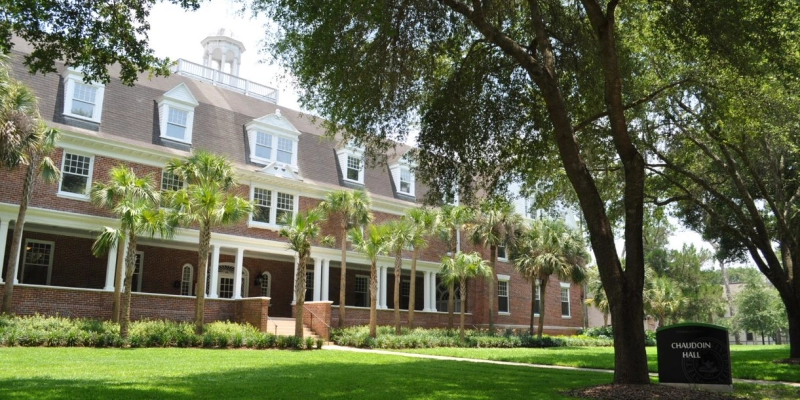How Chaudoin Caused a Housing Crisis
April 13, 2023
The summer before the Fall 2022 semester seemed to be promising. With virtually no COVID-19 restrictions for the first time in three years, the academic year was foreshadowed to finally have some semblance of normality. However, if things appear too good to be true, they often are. As Stetson University began to leave one disaster behind, another one struck: Chaudoin was effectively out of commission for this academic year, leading to what can only be described as a housing crisis.
On June 15, Residential Living and Learning was notified of a flameless electrical fire in the HVAC controls. This resulted in a permanent failure of part of the central unit. For safety reasons, the campers and live-in staff occupying the dormitory were relocated. According to an email that would soon be sent to Chaudoin residents, Facilities Management staff searched for a solution that would allow Chaudoin to reopen for the academic year. The university decided that none of the solutions would “provide an adequate level of service to residents.” For these reasons, it was decided on June 22 that Chaudoin would remain empty for the 2022-2023 academic year.
On July 6, Chaudoin residents received said email bearing the bad news: they would be reassigned to live elsewhere on campus. According to the email, the all-female dormitory experienced a power surge on June 7 during a lightning storm. Both the HVAC units and WIFI/Internet were damaged. Facilities Management and MyResNet staff were able to administer temporary solutions to the respective problems, allowing the group of summer campers to remain in the building.
A post was officially made on the Residential Living and Learning Instagram the next day on July 7, a day after Chaudoin residents received their emails. The post provided additional information about the school’s efforts to correct the situation. It read, “We have developed a reassignment strategy that will be directly communicated to students currently assigned to Chaudoin. All reassignments will be released by the end of July.” Additionally, the post informed the public that Risk Management had hired an inspector and Facilities Management had hired a company for air and surface testing.
The official plan going forward was to take advantage of the dormitory closure to complete an HVAC service and sprinkler system installation originally scheduled for the summer of 2023. As for Chaudoin residents, the idea was to keep the community together as much as possible. To do so, the school stated in the original email that the approximately 150 female-identifying students assigned to the main and north wings would be reassigned to Smith Hall.
According to Jess Day, the Executive Director of Residential Living and Learning, this decision did not affect a large population. Smith Hall was originally slated to be closed for the 2022-2023 academic year. Reassigning part of Chaudoin’s female population to the first-year area dormitory only affected the seven resident assistants and residents living in Smith singles. Even then, there was still a large population of individuals left without room assignments.
“We looked at our stock to see what [dorms] we could flip to female that were originally male,” Day explained. University Hall and Emily Hall were both readjusted to house a larger female population. “Then we desperately needed more spaces after calculating that out. That’s when I decided to actually take some of the sorority spaces as well,” Day said. This movement and relocation of so many students created an onslaught of problems.
Logan Flynn (’24), the current president of Delta Sigma Phi, has been vocal about such problems. “So far, in less than a one-week span, we’ve gone from only brothers and friends of the fraternity being explicitly stated as the only ones living within our house. Then we were told that every single room in our house was going to be fully filled by random students because the school didn’t have space for them elsewhere on campus,” Flynn said.
This announcement of non-affiliated students living inside the house came after a long series of emails between Residential Living and Learning staff and Flynn. On August 3, Flynn sent an email asking for a housing roster after the fraternity IFC representative alluded to the possibility of non-affiliated students moving into the fraternity house. The roster he received featured only brothers and one non-brother who the fraternity specifically requested to live in the house. Beth Eaton, the Assistant Director of Assignments, Data, and Logistics, confirmed via email on August 4 that those were the only people living inside the house.
“Then, on August 10 at 9:16 AM I was sent an email asking me if I wanted to reorganize the house because we were going to have random students placed in there. [Jess Day] said she needed that by 2 PM which was less than five hours on the same day… I said I would try to figure out how to do that. There were not many chapter leaders on campus at the time,” Flynn said, adding “I sent the roster at exactly 2 PM. I also learned that the housing department’s deadline to find people housing was 4:30 that day. So out of a bit of spite, I waited until the last minute because it seemed like they waited until the last minute.”
He cites a lack of communication between housing and the fraternities as the main source of the grievances fraternities currently have. “I can guarantee you that there’s been a lack of communication because I’ve initiated several communications, even beyond roster changes. I’ve had several emails go ignored,” Flynn said.
Several resident assistants share Logan’s general sentiment. Two resident assistants who chose to come forward and speak on the issue requested to remain anonymous for fear of retribution. One resident assistant (now referred to as RA 1 for anonymity) stated that instances of lack of communication have happened more than once. “They claim to bank it on a whole thing of transparency. But the transparency isn’t always fully there. [It’s] understandable that people are humans and mistakes can be made. But it does just happen so often that I know a lot of RAs are tired of [the lack of communication].”
Day feels otherwise, claiming transparency is one of her priorities this year. “The two things that I’m keeping a priority this year are transparency and care,” she said. One of the things she does to foster this is to facilitate an advisory council in which any resident assistant can meet with her and speak openly. Additionally, built out of the increased transparency and awareness, lead RAs get communications before the returning and new RAs. This allows them to be prepared for questions from residents.
Some resident assistants feel that there has not been a push for transparency, pointing at the Chaudoin closure as evidence. Another resident assistant (now referred to as RA 2 for anonymity) believes there is a lack of communication between housing and RAs. “We weren’t given any time to process it. I assumed that we were going to be finding out earlier, like a few days ahead of all the residents so we could prepare for any questions or anything. But to my surprise, all the residents were emailed about the closure a few hours later.” According to RA 2, the resident assistants were told not to tell anyone as it had not been announced to the general public.
Other issues compounded the general negative attitude resident assistants have toward their employers. First-year area RAs were originally promised a single, however, with the influx of residents, they were forced to have roommates. RA 1 labeled it a “false promise.” According to them, there were numerous resident assistants that had already moved into their rooms and situated themselves only to find out days later that they would be receiving a roommate. RA 2 knew of several instances where there was a large age disparity between the roommates, leaving roommates with feelings of discomfort.
Day explained that one of the reasons for such commotion was not only the closure of Chaudoin but the lack of what the university calls a melt. “Say we have a percentage of students that say they’re going to come to Stetson… Well, there is always a percentage each year that says they’re going to go somewhere else. Maybe they can’t come to Stetson or have a change of heart about college. We call that the melt. Well, the melt didn’t happen,” Day said. She explains that the school originally believed there would be 1500 students living on campus, but the number ended up being around 1700.
She states that everything happened so quickly, and despite housing being short-staffed this semester, they made sure to make a game plan for each step of the way. “So, it was just each step along the way. [It] was looking at numbers, making adjustments based off of that, obviously… All communication needs to go through multiple lines of communication to be able to make sure that we appropriately share it out with everybody in a timely manner,” Day said. According to her, Residential Living and Learning addressed every problem as they came up, which occasionally meant there was a short turnaround time between housing receiving the information and then disclosing it to resident assistants.
“I didn’t just fill the [first-year area] RA’s room. We filled the fraternities. We filled every sorority space… We have a Community Catalyst house program called the Russian house this year. There was a vacancy, I filled that with a temporary assignment too. We filled every bed space possible. We actually had six gentlemen we called on the day before move in, and asked them if they would be willing to commute because we didn’t have a space for them. There are many different reasons. There are people who are holding spaces; they weren’t completing their paperwork, to say that they were actually going to live off campus. That was causing us not to be able to have spaces available. We were anticipating melts… and we’re also down a person. So, it doesn’t help either. It’s just me and Beth doing all of this when it used to be another person,” Day said.
With such a rift left between Residential Living and Learning and the student community in the wake of the Chaudoin closure, it leaves the question of what can be done going forward to repair this fragile relationship.
“It will be very difficult,” said RA 1, adding “Truthfully, not a lot of people want to be RAs to begin with. You see a decent amount of understaffing when it comes to RAs… I think that anything is possible. We can’t write anything off, but it’s not going to be an overnight thing. I think that the university in general has to do a lot when it comes to taking care of their employees and have to really up the ante to motivate people to want to work here.”
RA 2 wants the university and student body to actively work on repairing their relationship. “It is really something we should take more of an initiative on… It’s a pretty big job and important for the school… RAs are the start of that process.”
Flynn believes this semester will be an important one for the relationship between housing and Greek life. “I think depending on the outcome of this semester, it will be a pivotal time for the two organizations. If we can come to a positive solution and work together, then I think that could be a great start to a positive relationship going forward,” Flynn said. He explained that younger fraternity members are easily influenced by how the older members interact with other school entities. “If I as a chapter president can go to my chapter and say ‘They owned their mess up and they’re helping us fix it,’… then it won’t further the notion that housing is the enemy,” Flynn said.
However, it could go in the opposite direction. “On the flip side, if this becomes something I have to fight all semester, I’m going to be frustrated and people can feel that energy coming out of organizations. It could quite easily ruin any chance at a relationship [between the two parties] in the next four years, which would be when the youngest people would be graduating,” Flynn said, adding, “ I have been told that there will be a lot of progress, but I have seen almost zero progress.”
Day wants the student community to know that Residential Living and Learning is here for every student and their unique situation. “Each of us have been taking time to be thoughtful and intentional to listen out [for problems] and actually try to resolve problems as we get them. I would encourage students to bring their concerns to the forefront… I would hope that students understand that we are trying to have their best interests in mind. In this work, we are here to listen,” Day said.
With a number of students still living in temporary room assignments, resident assistants continuing to be overwhelmed, and Greek organizations persistently adding to their list of grievances, the effects of the housing conundrum appear to be far from over. For now, the university and student body can only work on building a bridge to close the gap and meet in the middle. If and how they will do so remains to be seen.








